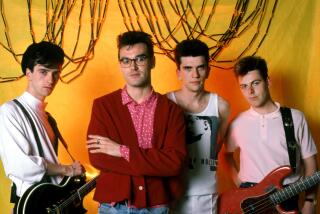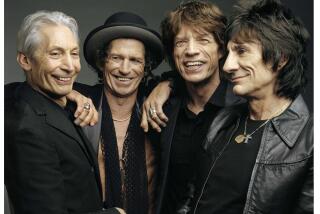Low-Key Entwistle Still Is Who’s Musical Anchor
- Share via
If a rock band were a human being, and the members were different parts of that individual, clearly songwriter-guitarist Pete Townshend would be the Who’s brain and singer Roger Daltrey its voice. Until his death in 1978 from a drug overdose, drummer Keith Moon was the legs on which the group moved.
But what of the enigmatic John Entwistle?
The tall, bearded bassist who typically stands motionless onstage, nonchalantly peeling off astonishingly unconventional parts that would challenge many a lead guitarist to duplicate, represents the Who’s central nervous system, without whose complex yet cohesive playing everything else would collapse on the floor in a flailing heap.
He’s widely regarded as one of the most accomplished bassists in all of rock--one who helped give the instrument a place of prominence alongside the lead guitar. Yet his profile in the Who was long overshadowed by the showier stage antics of the windmill-style guitar-thrashing and smashing Townshend, the microphone-twirling Daltrey and the drum-kit-bashing Moon.
Entwistle is secure with his place as the emotional and musical anchor, though, he says, “it took a long time to get to that space.” Readers of Total Guitar magazine recently voted him “Bassist of the Millennium,” an accolade he accepts with pride.
His approach to the bass “came from a need to have a much clearer bass sound.” Early on, Entwistle recalls, “our manager, Kit Lambert, said, ‘The bass sounds like a big blur--I can’t hear the notes you’re playing.’ To stop that, I just turned the treble up. It all started there. . . .
“I’d always played fast lead figures on the bass, and once you turn the treble up you can hear them,” he says. “It’s much harder to play with the treble up than without it. You can get away with murder on the bass with the treble down.”
Entwistle has amassed a collection of hundreds of basses over the years--he doesn’t know exactly how many he owns--first out of interest as a collector, later to create an arsenal to have at his disposal in the studio depending on what was called for.
“I have several stage basses I rely on and use all the time . . . one eight-string and three four-strings,” he says. “But my favorite is the one I used to record ‘Tommy’ and ‘Live at Leeds’: It’s called ‘Frankenstein,’ because I took parts of five smashed basses and stitched together one good one. I always seem to go back to that one.”
More to Read
The biggest entertainment stories
Get our big stories about Hollywood, film, television, music, arts, culture and more right in your inbox as soon as they publish.
You may occasionally receive promotional content from the Los Angeles Times.










